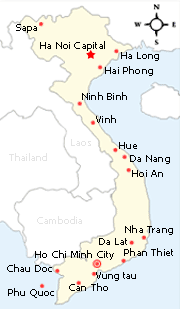|
Into the jungle Duc Hanh boats along the Giang river into the heart of Pu
Who are the Dan Lai? With a population of around 1,000 located in Pu Mat National Park in Nghe An province, the Dan Lai are one of the country’s more mysterious hill tribes. Not one of the official 54 ethnic groups residing in “We discovered the tribe in 1985 while patrolling the forest and border,” says Colonel Hoang Anh Thang from Nghe An province’s Border Patrol. “They call themselves Dan Lai as they are a hybrid of many tribes but not really similar to any of the other ethnic minorities.” The “Dan” is in reference to the village Dan Nhiem, a famous village in Nghe An province, where the Dan Lai claim to hail from originally; “Lai” means hybrid. Twenty-five years ago there were 3,000 Dan Lai but numbers have dwindled. The Dan Lai tribe can be found in Bung and Co Phat villages spread amongst 176 stilt houses. To get there you have to hire a boat and go upstream along the The low thatch-roofed houses of the Dan Lai people are protected from the elements in a dense forest. I’m happy to escape the boat and take cover under the trees as we trek towards the villages. In this part of the country, during the day the sun is scorching hot, but as night falls, suddenly it is cold. The villages only have rather feeble electric lights, which run on small water-powered generators. I’m introduced to La Van Quyet, the village patriarch. He tells me most of the Dan Lai belongs to the La clan as consanguineous marriages are so common. We take a tour of the village. The houses are small and rudimentary. There are no beds, mats, mosquito nets, tables or chairs. There is only a fire in the centre of each house. I notice that a few villagers are sleeping in a near foetal position. Both old people and young grasp their knees or use a bamboo stick to prop up their head. “The people here only lie down when they die, so sleeping on a bed is taboo,” explains Quyet. “Generation to generation, we have slept sitting up and given birth sitting up,” he continues. “Babies are often dipped in the According to Quyet there are many ways to sleep. Some sit on their knees or holding their own hands. Some use a bamboo stick to prop up their head. Others use a sling or a chock to support their neck while they sleep. “The way we sleep decides the existence of the tribe,” says Quyet mysteriously. But there are also more practical sounding sleeping habits. “We live in severe weather conditions in the midst of dangerous forest full of wild animals,” says Quyet. “The fire keeps us warm and keeps animals away, too.” When I ask where the Dan Lai come from, Quyet answers by saying: “Our forefather may be Kinh ( He tells us a story about a family from Nghe An in ancient times who were oppressed by a cruel Land God. He forced the family to find 100 golden bamboo trees and a magic boat. The request was impossible to fulfil. But the Land God threatened to kill the family if they failed. The family searched high and low but in the end they decided to was better to run and so they fled deep into the forest where they would not be found. Looking at the villagers sleeping while hunkered down, it’s as if they’ve ready to jump up and run, as if they still think the Land God might be coming. VietNamNet/Timeout
Other news for Tuesday 19 January, 2010
View all news for Tuesday 19 January, 2010 on one page News for Thursday 14 January, 2010
View all news for Thursday 14 January, 2010 on one page Recent News
|










